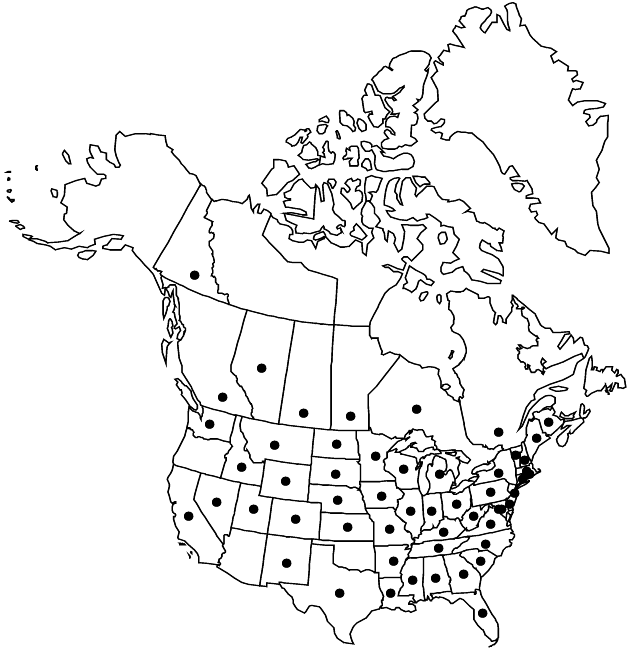Symphyotrichum laeve
Taxon 31: 359. 1982.
Perennials (15–) 20–70 (–120) cm, cespitose; stoutly short-rhizomatous, with thick, woody caudices or a few, long rhizomes. Stems 1–5+, erect (straight, glaucous, sometimes reddish proximally), glabrous, sometimes sparsely hirsute distally. Leaves (glaucous) thick, firm, ± fleshy, margins crenate-serrate or serrulate or entire, scabridulous, apices mucronulate, faces glabrous; basal usually withering by flowering or sometimes persistent (var. purpuratum), petiolate (petioles ± winged, bases dilated, sheathing), blades spatulate or oblong to ovate or lanceolate-ovate, 30–200 × 10–25 (–30) mm, bases attenuate or cuneate to rounded, margins crenate-serrate to serrulate, apices acute to obtuse or rounded; proximal cauline often withering by flowering, petiolate or subsessile or sessile (petioles narrowly to broadly winged, clasping), blades ovate or oblong-ovate to lanceolate or linear-lanceolate, sometimes ± panduriform, (40–) 80–150 (–180) × (10–) 20–45 mm, bases attenuate to rounded or ± shallowly auriculate-clasping, margins entire or shallowly crenate-serrate, minutely scabrous, apices acute or obtuse, callus-pointed; distal sessile, blades lanceovate or lanceolate to linear, 7–45 × 1–14 mm, progressively reduced distally (abruptly so in arrays), bases auriculate and ± clasping to rounded, margins entire. Heads in broad, sometimes ± flat-topped, paniculiform arrays, branches stiffly ascending (rarely arching), leafy with small, gradually reduced branch leaves. Peduncles 0.2–6+ cm, glaucous, glabrous or puberulent in lines, bracts 3–6, densely spaced, subulate or linear-lanceolate to linear, subclasping, apices sometimes purplish, grading into phyllaries. Involucres campanulate to cylindro-campanulate, (4.2–) 5–7 (–8) mm. Phyllaries in 4–6 series, appressed, subulate or lanceolate (outer) to oblong-lanceolate or linear-lancolate or oblanceolate, unequal (sometimes appearing subequal), bases indurate 1/2–3/4, margins scarious, erose, hyaline, ciliolate distally, green zones mostly diamond-shaped to ± lanceolate (some inner, or most in var. geyeri), apices acute to acuminate, sometimes ± obtuse, red-mucronate or apiculate, faces glabrous. Ray-florets (11–) 13–23 (–34); corollas usually pale to dark blue or purple, seldom white, laminae (6–) 7.2–11.3 (–14.6) × 1.5–2.5 mm. Disc-florets (17–) 19–33 (–43); corollas yellow turning purplish red, 3.5–6.1 mm, tubes slightly shorter than funnelform throats, lobes triangular, (0.4–) 0.6–1 mm. Cypselae deep purple to brown, oblong-obovoid, compressed, 2–3.5 mm, 4–5-nerved, faces glabrous or glabrate; pappi tawny to red or rose-tinged, 5–7 mm.
Distribution

Alta., B.C., Man., N.B., Ont., Que., Sask., Yukon, Ala., Ark., Calif., Colo., Conn., D.C., Del., Fla., Ga., Idaho, Ill., Ind., Iowa, Kans., Ky., La., Maine, Mass., Md., Mich., Minn., Miss., Mo., Mont., N.C., N.Dak., N.H., N.J., N.Mex., N.Y., Nebr., Nev., Ohio, Pa., R.I., S.C., S.Dak., Tenn., Tex., Utah, Va., Vt., W.Va., Wash., Wis., Wyo., ne Mexico, in other areas of Mexico, Central America, Europe
Discussion
Varieties 4 (4 in the flora).
Selected References
None.
Lower Taxa
Key
| 1 | Leaves lanceolate to ovate, conspicuously auriculate-clasping, lengths less than 5 times widths | > 2 |
| 1 | Leaves linear-lanceolate to linear, slightly auriculate-clasping, lengths often 5 times widths | > 3 |
| 2 | Phyllaries strongly unequal, green apical zones diamond-shaped | Symphyotrichum laeve var. laeve |
| 2 | Phyllaries unequal, green apical zones lanceolate | Symphyotrichum laeve var. geyeri |
| 3 | Basal leaves withering by flowering, cauline linear-lanceolate | Symphyotrichum laeve var. concinnum |
| 3 | Leaves mostly basal and proximal at flowering, mostly linear | Symphyotrichum laeve var. purpuratum |
"thick" is not a number.